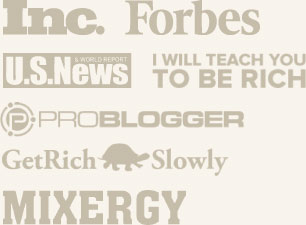The “Macklemore Effect”: How to Rocket to The Top of Any Industry–Even If You’re a Nobody Right Now
 Years ago, when I lived in Silicon Valley, there was a core group of about 50 people–the “cool kids”–who would make or break any social application that came about. Even though it often seemed, back in those days, that Twitter was down more often than it was up, the “cool kids” persisted in their use of it, and so it grew. Twitter’s founding team befriended and embraced the “cool kids” and success ensued.
Years ago, when I lived in Silicon Valley, there was a core group of about 50 people–the “cool kids”–who would make or break any social application that came about. Even though it often seemed, back in those days, that Twitter was down more often than it was up, the “cool kids” persisted in their use of it, and so it grew. Twitter’s founding team befriended and embraced the “cool kids” and success ensued.
Twitter was successful on a small scale until 2009, when Oprah joined it and Ashton Kutcher became the first person to get 1 million followers. The “cool kids” had started the revolution, but Oprah marked the day when Twitter became mainstream.
Over the years, the core group of “cool kids” slowly fragmented. Some of the influencers, like Robert Scoble, went on to grow huge networks of their own. (Scoble currently has 325,049 followers on Twitter and nearly half a million followers on Facebook.) Others returned to running startups, blogging, or even working a day job, much as they had done before. The “cool kids” didn’t as heavily influence Facebook’s rise to the top of social media, and they barely registered a blip as Pinterest pulled in record-breaking amounts of obsessed followers.
Many startups today try to implement that same model of getting Silicon Valley’s “digerati” to pay attention to their app/website/new social media network/whatever. The founders are convinced that if only Robert Scoble will do a video of their new company, or if TechCrunch will write an article about their latest round of funding, that they, too, will be successful. They see the outside results of something like Twitter, without understanding the view from inside the Valley–and how much things have changed over the past few years.
Are the “Cool Kids” Really the Ticket to Success?
You see, the influencers aren’t all in one place any more. It used to be that most of the tech press was in Silicon Valley, and that “core” of cool kids all hung out together at private San Francisco shindigs and swapped stories about the latest social media find. Back when no one knew what social media was, that was great. And so, back then, it was easier–if your app or company attracted the cool kids, you were in. And if it didn’t, scrap what you were doing and try again.
Along with Twitter, Facebook, and other sites, the Internet itself has gone mainstream. In under 20 years, we’ve gone from a handful of geeks broadcasting themselves live online (1995) to a Korean pop star getting 1 billion views of his video and dominating the worldwide Billboard charts for weeks. Anyone can be a celebrity, but at the same time, it’s harder than ever to stand out amongst all the noise.
Most startups and businesses jump right in to the top celebrities–the “cool kids”–in their industry, figuring that if those celebrities endorse their product, they’ve got it made. In rare cases, that does happen. But what’s more powerful is building a powerful product that pleases a small subset of people, and working out from there. Let’s call it the “Macklemore effect.”
In case you don’t know who Macklemore is, he’s the guy who sings the popular song “Thrift Shop.” He seemingly came out of nowhere, an independent artist whose latest album is now at the top of the charts.
But if you read deeper into his background, you’ll find out he’s been performing since 2000. His releases have been spotty, owing to an on-and-off drug addiction. But his music is addictive. He describes it this way in an interview with the Seattle Times:
“‘These days, there’s two different ways bands blow up,’ or get big, he says. ‘One of those, is they make a piece of work that the critics jump on right away … and that takes it to the next level very quickly.’
‘And then there’s another way, which is organically, spreading amongst the youth. To the point where those tastemakers can’t help but notice, ‘Hey, he’s selling out shows all over the place. Something’s happening here.'”
That interview, by the way, was published in 2011–before most of us knew who he was.
The “American Idol” Way
The first way is “American Idol.” And it’s what startups and business owners hope for. It is, in fact, the middle-class dream: To get “noticed”; to get a “big break”–to build something successful without having to do much work. Just sing your little heart out, and hope Simon Cowell or your industry’s biggest “cool kid” will pick you up for a contract.
Unfortunately, as many “Idol” contestants will testify, it also means you don’t have full control over your destiny.
The Macklemore Way
So what’s the other way? First, make something good. Really good. You’ll know you have it when people are spreading the word about your business–encouraging others to use your product without you having to do much marketing.
Then, focus on finding the smaller influencers in your niche. Twitter knew who they were in the Valley–before the Valley was big. They’re the people who write blogs about your market and who have a core group of people to whom they recommend products they love. Show them your product, and get them to fall in love with it. Then help them spread the word. (If your product is innovative and interesting, they’ll be happy to do so!)
There are some tricks, though. First, you have to know who in your niche is the right person to contact. Then, you have to get that person interested–tough, in a land where many non-famous folks receive hundreds of emails or messages a day!
And then, you have to get that person to take some action. Do you want a meeting? Do you want him or her to try out your product? To get results, you’ll need to ask for the specific thing you want from that person, and make sure he/she follows through.
How do you do all of that? I’d like to show you.
I’m producing a course called “Art of Email.” It’s all about how to reach the tastemakers in your niche. In the course, I’ll show you (with step-by-step templates) how to get publicity, press, investors, customers, and more–all by sending a few well-crafted emails.
I’ll even show you how to find any celebrity’s email address (I’ll give you Mark Cuban’s email address as an example.)
Want to be the first one to check out “Art of Email”–and get some additional freebies as well, just for being the first one to take it for a test drive? Put in your best email address in the box below and you’ll be the first to know when I launch it:
(Note: If you’re already subscribed to my email list, this is a different email list, so please make sure to add your email address here so you are the first to know when I launch and you get all the cool free stuff as well!)


